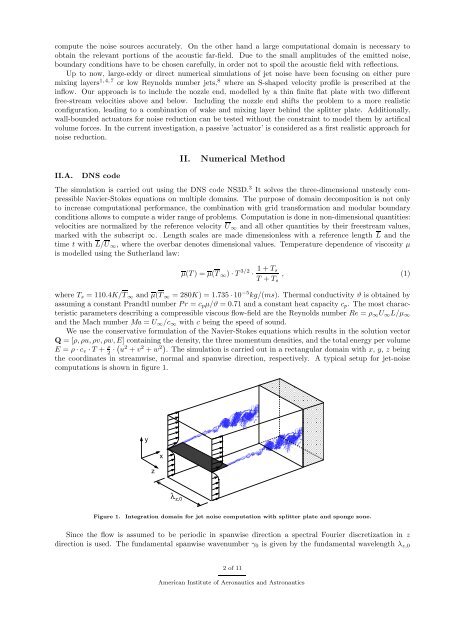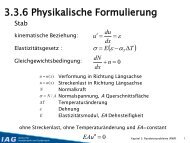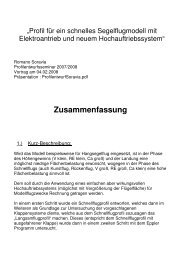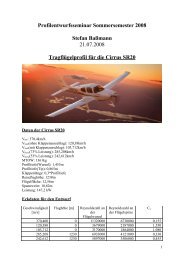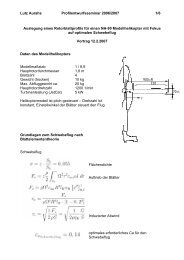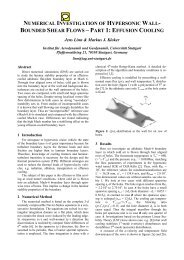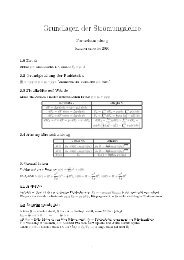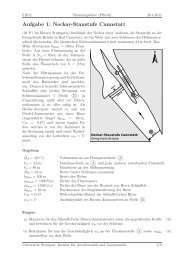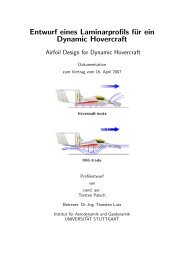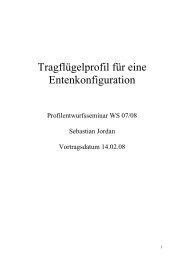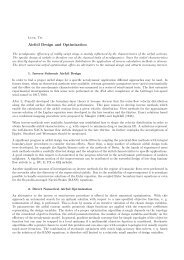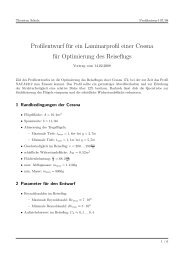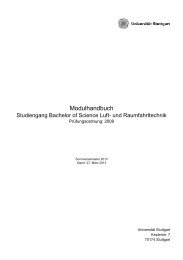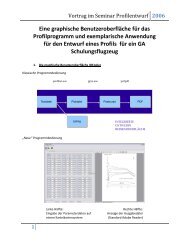pdf-File - IAG - Universität Stuttgart
pdf-File - IAG - Universität Stuttgart
pdf-File - IAG - Universität Stuttgart
You also want an ePaper? Increase the reach of your titles
YUMPU automatically turns print PDFs into web optimized ePapers that Google loves.
compute the noise sources accurately. On the other hand a large computational domain is necessary to<br />
obtain the relevant portions of the acoustic far-field. Due to the small amplitudes of the emitted noise,<br />
boundary conditions have to be chosen carefully, in order not to spoil the acoustic field with reflections.<br />
Up to now, large-eddy or direct numerical simulations of jet noise have been focusing on either pure<br />
mixing layers 1,4,7 or low Reynolds number jets, 8 where an S-shaped velocity profile is prescribed at the<br />
inflow. Our approach is to include the nozzle end, modelled by a thin finite flat plate with two different<br />
free-stream velocities above and below. Including the nozzle end shifts the problem to a more realistic<br />
configuration, leading to a combination of wake and mixing layer behind the splitter plate. Additionally,<br />
wall-bounded actuators for noise reduction can be tested without the constraint to model them by artifical<br />
volume forces. In the current investigation, a passive ’actuator’ is considered as a first realistic approach for<br />
noise reduction.<br />
II.A.<br />
DNS code<br />
II. Numerical Method<br />
The simulation is carried out using the DNS code NS3D. 3 It solves the three-dimensional unsteady compressible<br />
Navier-Stokes equations on multiple domains. The purpose of domain decomposition is not only<br />
to increase computational performance, the combination with grid transformation and modular boundary<br />
conditions allows to compute a wider range of problems. Computation is done in non-dimensional quantities:<br />
velocities are normalized by the reference velocity U ∞ and all other quantities by their freestream values,<br />
marked with the subscript ∞. Length scales are made dimensionless with a reference length L and the<br />
time t with L/U ∞ , where the overbar denotes dimensional values. Temperature dependence of viscosity µ<br />
is modelled using the Sutherland law:<br />
µ(T) = µ(T ∞ ) · T 3/2 · 1 + T s<br />
T + T s<br />
, (1)<br />
where T s = 110.4K/T ∞ and µ(T ∞ = 280K) = 1.735 · 10 −5 kg/(ms). Thermal conductivity ϑ is obtained by<br />
assuming a constant Prandtl number Pr = c p µ/ϑ = 0.71 and a constant heat capacity c p . The most characteristic<br />
parameters describing a compressible viscous flow-field are the Reynolds number Re = ρ ∞ U ∞ L/µ ∞<br />
and the Mach number Ma = U ∞ /c ∞ with c being the speed of sound.<br />
We use the conservative formulation of the Navier-Stokes equations which results in the solution vector<br />
Q = [ρ, ρu, ρv, ρw, E] containing the density, the three momentum densities, and the total energy per volume<br />
E = ρ · c v · T + ρ 2 · (u 2 + v 2 + w 2) . The simulation is carried out in a rectangular domain with x, y, z being<br />
the coordinates in streamwise, normal and spanwise direction, respectively. A typical setup for jet-noise<br />
computations is shown in figure 1.<br />
y<br />
z<br />
x<br />
0000000000000000<br />
1111111111111111<br />
0000000000000000<br />
1111111111111111<br />
0000000000000000<br />
1111111111111111<br />
0000000000000000<br />
1111111111111111<br />
0000000000000000<br />
1111111111111111<br />
0000000000000000<br />
1111111111111111<br />
0000000000000000<br />
1111111111111111<br />
0000000000000000<br />
1111111111111111<br />
0000000000000000<br />
1111111111111111<br />
0000000000000000<br />
1111111111111111<br />
0000000000000000<br />
1111111111111111<br />
0000000000000000<br />
1111111111111111<br />
0000000000000000<br />
1111111111111111<br />
0000000000000000<br />
1111111111111111<br />
0000000000000000<br />
1111111111111111<br />
0000000000000000<br />
1111111111111111<br />
0000000000000000<br />
1111111111111111<br />
0000000000000000<br />
1111111111111111<br />
0000000000000000<br />
1111111111111111<br />
0000000000000000<br />
1111111111111111<br />
0000000000000000<br />
1111111111111111<br />
λ z,0<br />
Figure 1. Integration domain for jet noise computation with splitter plate and sponge zone.<br />
Since the flow is assumed to be periodic in spanwise direction a spectral Fourier discretization in z<br />
direction is used. The fundamental spanwise wavenumber γ 0 is given by the fundamental wavelength λ z,0<br />
2 of 11<br />
American Institute of Aeronautics and Astronautics


